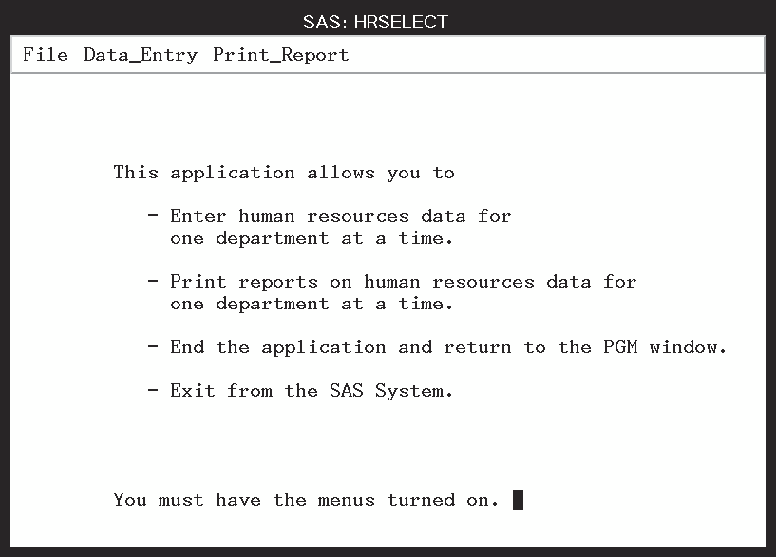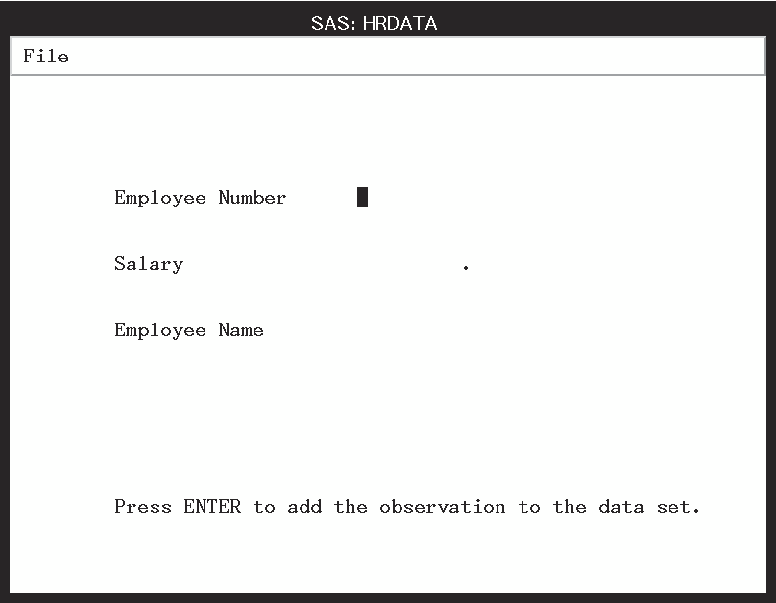PMENU Procedure
Example 4: Creating Menus for a DATA Step Window Application
| Features: |
DIALOG statement SELECTION statement |
| Other features: |
FILENAME statement |
Details
This example defines
an application that enables the user to enter human resources data
for various departments, and to request reports from the data sets
that are created by the data entry.
Program
libname proclib
'SAS-data-library';
filename de 'external-file'; filename prt 'external-file';
proc pmenu catalog=proclib.menus;
menu select;
item 'File' menu=f; item 'Data_Entry' menu=deptsde; item 'Print_Report' menu=deptsprt;
menu f;
item 'End this window' selection=endwdw;
item 'End this SAS session' selection=endsas;
selection endwdw 'end';
selection endsas 'bye';
menu deptsde;
item 'For Dept01' selection=de1;
item 'For Dept02' selection=de2;
item 'Other Departments' dialog=deother;
selection de1 'end;pgm;include de;change xx 01;submit';
selection de2 'end;pgm;include de;change xx 02;submit';
dialog deother 'end;pgm;include de;c deptxx @1;submit';
text #1 @1 'Enter department name';
text #2 @3 'in the form DEPT99:';
text #2 @25 len=7;
menu deptsprt;
item 'For Dept01' selection=prt1;
item 'For Dept02' selection=prt2;
item 'Other Departments' dialog=prother;
selection prt1
'end;pgm;include prt;change xx 01 all;submit';
selection prt2
'end;pgm;include prt;change xx 02 all;submit';
dialog prother 'end;pgm;include prt;c deptxx @1 all;submit';
text #1 @1 'Enter department name';
text #2 @3 'in the form DEPT99:';
text #2 @25 len=7;
run;
menu entrdata;
item 'File' menu=f;
menu f;
item 'End this window' selection=endwdw;
item 'End this SAS session' selection=endsas;
selection endwdw 'end';
selection endsas 'bye';
run;
quit;Program Description
Declare the DE and PRT filenames. The FILENAME statements define the external files
in which the programs to create the windows are stored.
Specify the catalog for storing menu definitions. Menu definitions will be stored in the PROCLIB.MENUCAT
catalog.
Specify the name of the catalog entry. The MENU statement specifies SELECT as the name
of the catalog entry. The menus are stored in the catalog entry PROCLIB.MENUS.SELECT.PMENU.
Design the menu bar. The
ITEM statements specify the three items on the menu bar. The value
of the MENU= option is used in a subsequent MENU statement.
Design the File menu. This
group of statements defines the selections under File. The value of
the SELECTION= option is used in a subsequent SELECTION statement.
menu f;
item 'End this window' selection=endwdw;
item 'End this SAS session' selection=endsas;
selection endwdw 'end';
selection endsas 'bye';Design the Data_Entry menu. This
group of statements defines the selections under Data_Entry on the
menu bar. The ITEM statements specify that For Dept01 and For Dept02
appear under Data_Entry. The value of the SELECTION= option equates
to a subsequent SELECTION statement, which contains the string of
commands that are actually submitted. The value of the DIALOG= option
equates to a subsequent DIALOG statement, which describes the dialog
box that appears when this item is selected.
menu deptsde;
item 'For Dept01' selection=de1;
item 'For Dept02' selection=de2;
item 'Other Departments' dialog=deother;Specify commands under the Data_Entry menu. The commands in single quotation marks are submitted
when the user selects For Dept01 or For Dept02. The END command ends
the current window and returns to the PROGRAM EDITOR window so that
further commands can be submitted. The INCLUDE command includes the
SAS statements that create the data entry window. The CHANGE command
modifies the DATA statement in the included program so that it creates
the correct data set. The SUBMIT command submits the DATA step program.
selection de1 'end;pgm;include de;change xx 01;submit';
selection de2 'end;pgm;include de;change xx 02;submit';Design the DEOTHER dialog box. The
DIALOG statement defines the dialog box that appears when the user
selects Other Departments. The DIALOG statement modifies the command
string so that the name of the department that is entered by the user
is used to change
deptxx in the SAS program
that is included. The first two TEXT statements specify text that
appears in the dialog box. The third TEXT statement specifies an input
field. The name that is entered in this field is substituted for the
@1 in the DIALOG statement. dialog deother 'end;pgm;include de;c deptxx @1;submit';
text #1 @1 'Enter department name';
text #2 @3 'in the form DEPT99:';
text #2 @25 len=7;Design the Print_Report menu. This
group of statements defines the choices under the Print_Report item.
These ITEM statements specify that For Dept01 and For Dept02 appear
in the menu. The value of the SELECTION= option equates to a subsequent
SELECTION statement, which contains the string of commands that are
actually submitted.
menu deptsprt;
item 'For Dept01' selection=prt1;
item 'For Dept02' selection=prt2;
item 'Other Departments' dialog=prother;Specify commands for the Print_Report menu. The commands in single quotation marks are submitted
when the user selects For Dept01 or For Dept02. The END command ends
the current window and returns to the PROGRAM EDITOR window so that
further commands can be submitted. The INCLUDE command includes the
SAS statements that print the report. (For more information,
see Printing a Program.)
The CHANGE command modifies the PROC PRINT step in the included program
so that it prints the correct data set. The SUBMIT command submits
the PROC PRINT program.
selection prt1
'end;pgm;include prt;change xx 01 all;submit';
selection prt2
'end;pgm;include prt;change xx 02 all;submit';Design the PROTHER dialog box. The
DIALOG statement defines the dialog box that appears when the user
selects Other Departments. The DIALOG statement modifies the command
string so that the name of the department that is entered by the user
is used to change
deptxx in the SAS program
that is included. The first two TEXT statements specify text that
appears in the dialog box. The third TEXT statement specifies an input
field. The name entered in this field is substituted for the @1 in
the DIALOG statement. dialog prother 'end;pgm;include prt;c deptxx @1 all;submit';
text #1 @1 'Enter department name';
text #2 @3 'in the form DEPT99:';
text #2 @25 len=7;Other Examples
Associating a Menu with a Window
The first group of statements
defines the primary window for the application. These statements are
stored in the file that is referenced by the HRWDW fileref:
The WINDOW statement
creates the HRSELECT window. MENU= associates
the PROCLIB.MENUS.SELECT.PMENU entry with this window.
data _null_;
window hrselect menu=proclib.menus.select
#4 @10 'This application allows you to'
#6 @13 '- Enter human resources data for'
#7 @15 'one department at a time.'
#9 @13 '- Print reports on human resources data for'
#10 @15 'one department at a time.'
#12 @13 '- End the application and return to the PGM window.'
#14 @13 '- Exit from the SAS System.'
#19 @10 'You must have the menus turned on.';Using a Data Entry Program
When the user selects
Data_Entry from
the menu bar in the HRSELECT window, a menu
is displayed. When the user selects one of the listed departments
or chooses to enter a different department, the following statements
are invoked. These statements are stored in the file that is referenced
by the DE fileref.
The WINDOW statement
creates the HRDATA window. MENU= associates
the PROCLIB.MENUS.ENTRDATA.PMENU entry with the window.
data proclib.deptxx;
window hrdata menu=proclib.menus.entrdata
#5 @10 'Employee Number'
#8 @10 'Salary'
#11 @10 'Employee Name'
#5 @31 empno $4.
#8 @31 salary 10.
#11 @31 name $30.
#19 @10 'Press ENTER to add the observation to the data set.';The %INCLUDE statement
recalls the statements in the file HRWDW. The statements in HRWDW
redisplay the primary window. See the HRSELECT
window
The SELECTION and DIALOG
statements in the PROC PMENU step modify the DATA statement in this
program so that the correct department name is used when the data
set is created. That is, if the user selects
Other Departments and
enters DEPT05, then the DATA statement is
changed by the command string in the DIALOG statement to
Printing a Program
When the user selects
Print_Report from
the menu bar, a menu is displayed. When the user selects one of the
listed departments or chooses to enter a different department, the
following statements are invoked. These statements are stored in the
external file referenced by the PRT fileref.
libname proclib
'SAS-data-library';
proc print data=proclib.deptxx;
title 'Information for deptxx';
run;This PROC PRINTTO step
restores the default output destination. See PRINTTO Procedure


